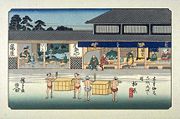
Kashiwabara-juku
Encyclopedia

69 Stations of the Nakasendo
The are the rest areas along the Nakasendō, which ran from Nihonbashi in Edo to Sanjō Ōhashi in Kyoto. The route stretched approximately and was an alternate trade route to the Tōkaidō.-Stations of the Nakasendō:...
of the Nakasendō
Nakasendo
The , also called the , was one of the five routes of the Edo period, and one of the two that connected Edo to Kyoto in Japan. There were 69 stations between Edo and Kyoto, crossing through Musashi, Kōzuke, Shinano, Mino and Ōmi provinces...
. It is located in the present-day city of Maibara
Maibara, Shiga
is a city located in Shiga Prefecture, Japan.As of August 1, 2006, the city has an estimated population of 42,154. The total area is 223.1 km².- History :...
, Shiga Prefecture
Shiga Prefecture
is a prefecture of Japan, which forms part of the Kansai region on Honshu Island. The capital is the city of Ōtsu.- History :Shiga was known as Ōmi Province or Gōshū before the prefectural system was established...
, Japan
Japan
Japan is an island nation in East Asia. Located in the Pacific Ocean, it lies to the east of the Sea of Japan, China, North Korea, South Korea and Russia, stretching from the Sea of Okhotsk in the north to the East China Sea and Taiwan in the south...
.
History
Records of Kashiwabara-juku itself date back to the Middle Ages when it was mentioned in the TaiheikiTaiheiki
The is a Japanese historical epic , written in the late 14th century. It deals primarily with the Nanboku-chō, the period of war between the Northern Court of Ashikaga Takauji in Kyoto, and the Southern Court of Emperor Go-Daigo in Yoshino....
, a historical epic of Japan. A post station
Shukuba
were post stations during the Edo period in Japan, generally located on one of the Edo Five Routes or one of its sub-routes. They were also called shukueki . These post stations were places where travelers could rest on their journey around the nation...
was first established in the Kashiwabara-juku area in 646. The Kashiwabara-juku established by Tokugawa Ieyasu
Tokugawa Ieyasu
was the founder and first shogun of the Tokugawa shogunate of Japan , which ruled from the Battle of Sekigahara in 1600 until the Meiji Restoration in 1868. Ieyasu seized power in 1600, received appointment as shogun in 1603, abdicated from office in 1605, but...
in the 17th century was approximately 1.5 km (0.93205910497471 mi) from east to west, making it one of the larger post stations along the Nakasendō. Different sources place the number of hatago
Hatago
were Edo period lodgings for travelers at shukuba along the national highways, including the Edo Five Routes and the subroutes. In addition to a place to rest, hatago also offered meals and other foods to the travelers...
as either 344 or 457, though either number would be large when compared to other post stations.
In 1996, a study was conducted which showed that over one-fifth of the structures in the Kashiwabara-juku area were built in the either the Edo
Edo period
The , or , is a division of Japanese history which was ruled by the shoguns of the Tokugawa family, running from 1603 to 1868. The political entity of this period was the Tokugawa shogunate....
or Meiji
Meiji period
The , also known as the Meiji era, is a Japanese era which extended from September 1868 through July 1912. This period represents the first half of the Empire of Japan.- Meiji Restoration and the emperor :...
periods. Nowadays, it is known for its wormwood
Artemisia vulgaris
Artemisia vulgaris is one of several species in the genus Artemisia which have common names that include the word mugwort. This species is also occasionally known as Felon Herb, Chrysanthemum Weed, Wild Wormwood, Old uncle Henry, Sailor's Tobacco, Naughty Man, Old Man or St...
, which is the local specialty. At one point, there were over ten shops that specialized in wormwood products.

